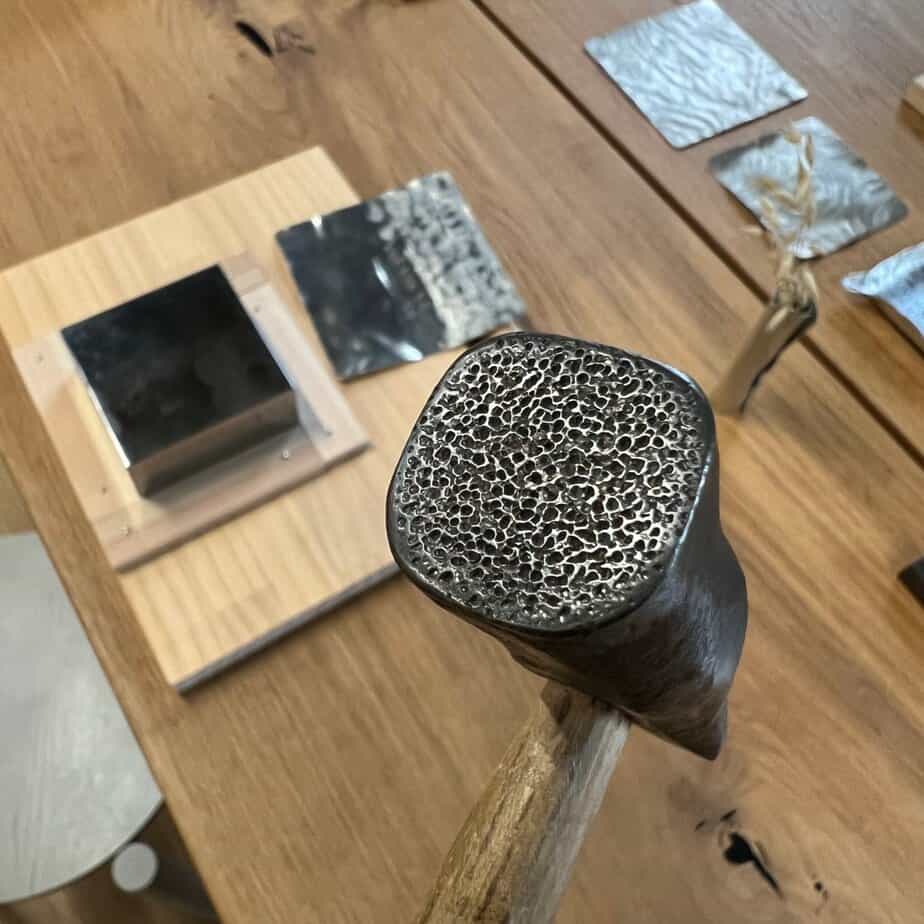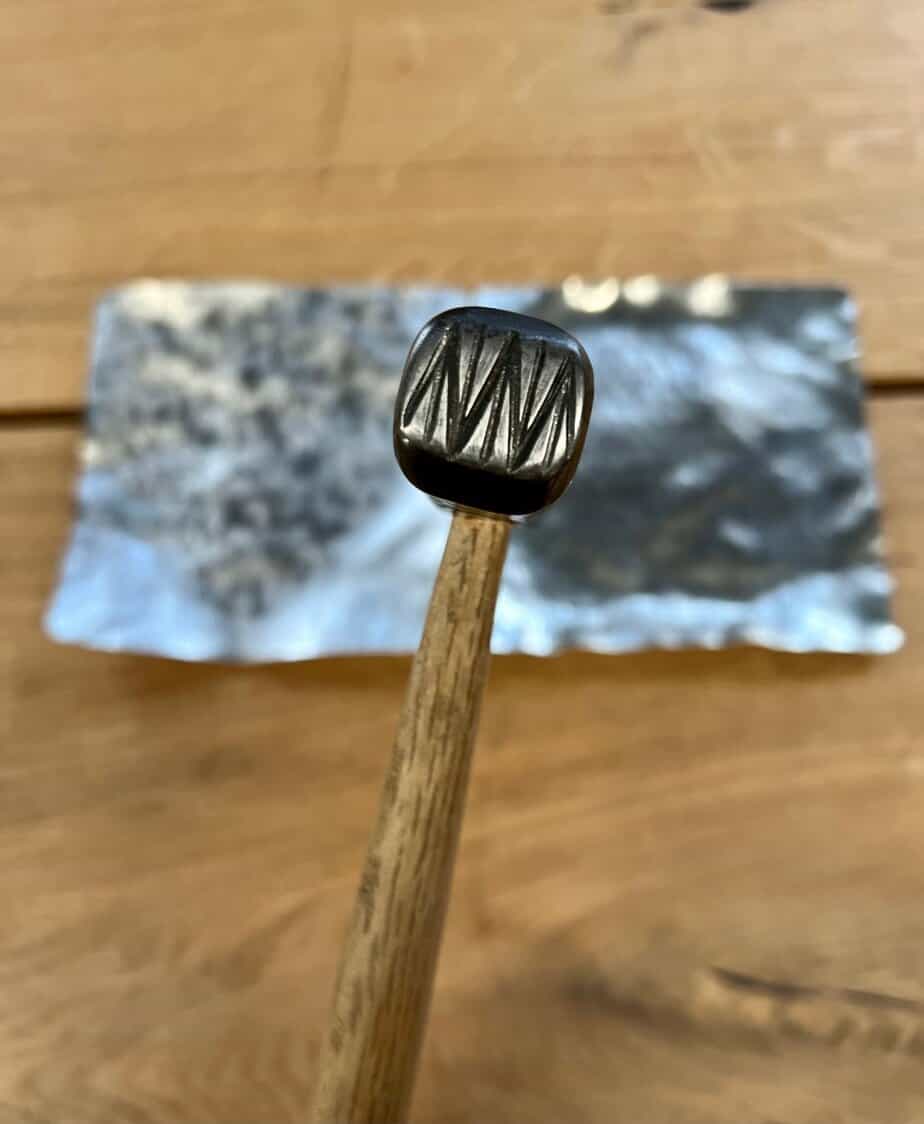The Pantechnicon building can be relied on to spirit you away from everyday London life. On our last visit, we elevated up to the Roof Garden to enjoy some delightful dishes, cocktails and views during the golden sunset hours. This Saturday we visited a little earlier in the day to join a truly unique crafts workshop with Suzugami artisan Yoshinori Shimatani. This was held on the first floor studio which you can find your way up to either via the stylish glass lift or the stairs. If you do take the stairs do be warned that you will be tempted by the fantastic food and matcha of Cafe Kitsune that you see on the mezzanine floor. However it’s always good to know that you have some treats waiting for you after you finish your workshop!
In case you are wondering what Suzugami is, the literally translation is “tin paper”. They are all handcrafted by highly skilled Japanese artisans who use traditional techniques to create beautiful tin plates which can be bent and folded like origami. As these tin paper are compressed and rhythmically hammered into place, there are no worries of the plates not reforming after bending or streching.
The Suzugami workshops at Pantechnicon are led by 4th generation metal artisan Yoshinori Shimatani who founded the Shouryu Suzugami brand. Shimatani-san hails from Takaoka City in Toyama, a city renown for its metal craftsmen. He uses the same craft techniques that are traditionally used to create Orin Buddhist Bells when making Suzugami, and in the workshops participants learn how to embellish the Suzugami with designs created by special hammers. As there are only 3 spaces in each workshop, you get to have plenty of 1 on 1 time with Shimatani-san and even if you are a true novice when it comes to crafts (like us), Shimatani-san is there to give advice as you make your very own Suzugami that you can take home afterwards.
Our Suzugami Workshop Experience
First after a quick introduction and greetings with our teacher Shimatani-San (we will of course use the honorific Sensei during this workshop) and our translator Akai-san, we get a demonstration from Shimatani-Sensei on how to embellish the Suzugami sheet. Essentially the hard work has already all been done for participants, and they are literally given a blank canvas or Suzugami sheet to design the way they like. Their “brushes” for the canvas are one of three hammers which both have different weather-inspired designs on their heads. Each hammer will leave a different print, and you can choose from Samidare (rain), Kazahana (snowflakes), or Arare (hail).

What Shimatani-Sensei is keen to point out is that whichever hammer we use, the hammer must be kept flat so the surface and print touches as much of the Suzugami sheet as possible. You don’t want the edges of the hammer head to strike the sheet otherwise you won’t get the full inprint on your sheet, and you make it harder to keep the pattern uniform (if this is what you are going for).
It might seem simple but actually when you try it’s surprising tricky to keep the hammer straight when striking the Suzugami. Luckily Shimatani-Sensei was at hand to give some tips on what angle to hold the hammer, and rather than striking, a rhythmic tapping could be a better description of how to achieve the desired effect.

In my case, I was accidentally striking the sheet with the top left of the hammer head. Here, Shimatani-Sensei gave a tip that I should focus on the bottom right side of the hammer to get the right balance. After a few more taps, I could see this was working and within a minute a beautiful pattern was appearing on the sheet, and the intervals between taps became a lot shorter!
It was really quite a soothing, peaceful and liberating experience creating this piece of work. You can hammer along once you get into rhythm and simply admire what you are making. You geninuely want to keep going once you’ve finished your sheet too. As mentioned your Suzugami design is up to you. If you want to hammer out your name or initials that is absolutely your call. You could also try some options like keeping 2/3 of the sheet without a design. Or you could go all out and try to create some more elaborate images all of your own.
After you’re satisfied with your artwork, it’s time to bend it into shape. Again there’s no hard or fast rules but the general way is to slightly bend the four corners and then pinch the edges of the corners. Perhaps it’s easier to see in this image below where I’ve placed my finished Suzugami on the left hand side.

How you can use your Suzugami
Apart from the aesthetic beauty of the Suzugami, there is also a creativity and certain pleasure you can get from bending and folding it into numerous shapes. They can be used for ornamental purposes as well as accessory holders or plates for eating sweets. There are a couple of things to bear in mind when it comes to usage and care:
- Suzugami are great for sweets or food you can pick up by hand or chopsticks
- It is not recommended to use knives or forks or metal spoons that could scratch them
- Do not put them in a microwave or a hot oven which will damage them
- They can be put into a dishwasher but it would be a lot safer to handwash them
- While they can be bent many times, they are not a toy (if they are bent back and forth continuously for an extended period of time they are likely to break)
Questions we asked Shimatani-san after the workshop

What was great about this experience was there was plenty of time after creating your Suzugami plates to ask Shimatani-san questions about Orin, Takaoka and Suzugami. Here are the ones that we asked:
Question 1: There are 10 Buddhist Bell artisans in Japan. Who are the other nine artisans and which Buddhist sects do you all work with?
Shimatani-san: One is my relative in Takaoka and then there are some in Kyoto and then across Japan. I personally work with every type of Buddhist sect in Japan. I also make bells for clients in Hong Kong, China and Taiwan.
Question 2: Why did Takaoka become the centre of metal crafts?
Shimatani-san: This is due to influencer of the Kaga domain and the Maeda clan. They brought over metal artisans and specialists from across Japan including Kyoto and Osaka. At first these metal craftsmen specialised in created weapons but during the peaceful Edo period they become famous for making household and kitchen wares as well as metalwork such as Orin Buddhist bells.

Question 3: How is the Suzugami tin paper prepared before it is ready to be embellished?
Shimatani-san: First the raw tin material is heated to 230 degrees in a large pan. It is then put into a mold to form metal sheets which are about 15 centimetres in width. After this, a press is used to flatten and lengthen the sheet further. By this process it gets to the form you see it where it is only a few millimetres thick. We create four sizes and the one we are using at the workshop is the second smallest size.
Question 4: What does Shoryu mean?
Shimatani-san: When we make Orin bells, the sound of the hammer striking the metal is said to be like the cry of a baby dragon. Also in Japanese the meaning of Shoryu is Rising Dragon or a dragon flying up into the sky. Incidentally, Shoryu written in Japanese is the brand name for making Orin Buddhist Bells while the Shroyu name written in Roman alphabet is for my Suzugami work.
Question 5: Were you influenced by working closely with monks and did you become a more peaceful person?
Shimatani-san: You actually need to be calm and at peace at all times to create Orin bells. If you are not, this will affect the bells that you create. You can not be angry or irritated otherwise this will mean you can’t form the bells in the correct way and they may emit a sound that is not soothing or allows focus.
What Toyama products are exclusively on offer at Pantechnicon?

On the ground floor of Pantechnicon you’ll find Edit, a well-lit and carefully curated space where you can discover a whole world of lifestyle goods. In the first week of November there was one corner dedicated to Toyama prefecture which was easy to spot with the map of Japan showing where Toyama is in proximity to Tokyo and Kyoto. You could also watch a short video on Toyama by the tourism board and why it would be worth visiting when planning out a future Japan trip.

The corner had a wide range of exclusive craft products all from Toyama. The Nousaku pieces you see in the photo above here are all hand-finished by a skilled craftsman. The beautiful gold and silver coated lace or star coasters to the left are made from 100% soft tin and can change shape depending on how you wish to use them.

Then there was these cute “lucky fish” chopstick rests which are also made by Nousaku. In Japanese, sea bream are called Tai, which sounds like the Japanese word for congratulations – “medetai”. Because of this Tai is synonymous with happy occasions so these chopsticks rests would make a perfect wedding present or birthday gift!

As you may expect, there were also Shoryu products made by Shimatani-san including all the Suzugami tin paper sizes. Here you can see the largest plate adorned with the Kazahana pattern – a pattern that expresses the image of freshly fallen snow. These Suzugami would make for a wonderful beautiful or holiday season present but as there are only a limited number left we would advise getting them soon if they catch your eye.
While the Toyama pop-up store at Pantechnicon has now finished, you can still buy Suzugami plates at Ki:ts London which sells a curated selection of eclectic products from independent UK and Japanese brands like Shimatani’s Shoryu Suzugami plates. There are also many other delightful lifestyle goods such as tableware, Imabari towels, candles, as well as Matcha green tea.
We hope you found this article a great insight into Suzugami, Shimatani-san, Shoryu and Pantechnicon’s workshops. We’d like to thank Pantechnicon for inviting us to join the workshop, Shimatani-san for his stellar guidance, and Akai-san for his wonderful interpretation. Although we did not mention earlier in the article, Akai-san is a well-respected guide in Japan who is instantly recognisable as he’s always wearing red.
If you enjoyed about Suzugami and are interested in learning more about Japanese culture and events, we would whole-heartedly recommend checking our Japanese culture section. Also in case you are considering visiting Toyama or Japan in the near future, please take a look at our Japan travel tips.


